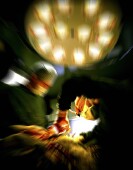
TUESDAY, March 11, 2014 (HealthDay News) — Two surgeries are equally effective and safe for women who have pelvic problems that can cause pain and incontinence, say the authors of a new study.
Pelvic organ prolapse is a weakening of the pelvic organs often seen in older women and those who’ve given birth several times. Surgeons typically choose one of two procedures to repair the condition, but little hard data has been available to back up their choice.
This study of nearly 400 women at nine U.S. medical centers found comparable success rates for both vaginal procedures.
“The two surgeries to correct apical prolapse performed equally, and that will allow specialists in this area to tailor the individual operation to a patient’s specific needs using either of the surgeries,” said study author Dr. Matthew Barber, professor of surgery at the Cleveland Clinic Lerner College of Medicine at Case Western Reserve University.
Barber said the second message that came out of the study was that Kegel-type pelvic muscle exercises seem to offer no extra benefits as an addition to surgery.
The study included 374 women who underwent procedures between 2008 and 2013. The participants were randomly assigned to one of two surgery groups — either sacrospinous ligament fixation or uterosacral ligament suspension. Both involve stitching the top of the vagina to ligaments inside the pelvic cavity.
After surgery, half of the women also received either behavioral therapy that included exercises to help strengthen muscles that support the uterus, bladder and rectum, or typical post-surgery follow-up care.
Two years later, both procedures had about a 60 percent surgical success rate, according to the study, published in the March 12 issue of the Journal of the American Medical Association.
Barber, who is also vice-chair of clinical research in the Ob/Gyn and Women’s Health Institute at Cleveland Clinic, said about 300,000 women undergo pelvic organ prolapse surgery every year in the United States.
Dr. Quoc-Dien Trinh, a urologic surgeon at Brigham and Women’s Hospital in Boston who was not involved in the research, said the study was important because it compared the effectiveness of two of the most commonly performed procedures to correct apical vaginal prolapse.
“This finding is quite important as both procedures are safe and both had comparable success rates,” he said. The study also showed that pelvic muscle training may only hold benefits for a small subset of patients undergoing surgery for apical vaginal prolapse, and that it’s a question that needs further study, he noted.
If both surgeries work equally well, how do a surgeon and patient choose the best option? Trinh said based on the lack of evidence supporting one technique over the other, surgeons should offer their patients the technique they’re most familiar with and comfortable performing.
From the patient’s perspective, an important factor will be the consideration of side effects, he noted. “For example, the rate of neurologic pain requiring intervention was higher in the [sacrospinous ligament fixation] group,” Trinh said. But ureteral obstruction — a blockage in one or both tubes (ureters) that lead from the kidneys to the bladder — was only seen in the [uterosacral ligament suspension] group.
“Patients should choose the approach they are most comfortable with, given the potential adverse outcomes of each,” said Trinh.
Barber said in some cases a surgeon might make the call in the operating room, after starting surgery. Knowing both procedures are equally effective and safe is reassuring and allows the surgeon to provide the best option, he explained.
Barber said he hopes the study will also bring attention to an issue a lot of women live with but hesitate to seek treatment for because they believe there are no solutions.
“It’s a condition that’s very common. Studies like this not only provide us with useful information but they raise awareness, and patients may be more likely to bring it up with their doctors,” Barber said.
More information
Visit the Women’s Center for Pelvic Health at Johns Hopkins Medicine for more on women’s pelvic health issues.
Copyright © 2025 HealthDay. All rights reserved.

